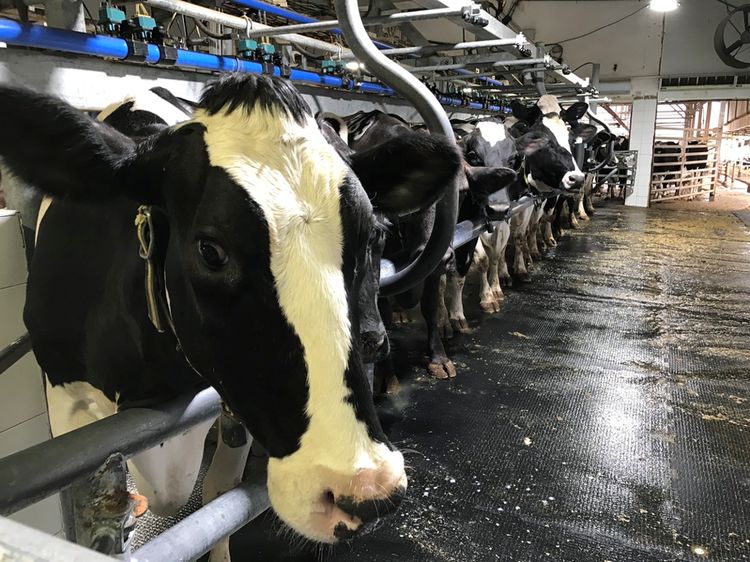Dairy farming is a type of agriculture where cows produce milk and other dairy products. This type of farming has a long history dating back to the seventh millennium BC in the early Neolithic age. It was widespread in many regions of Africa and Europe. Today, dairy farms are still popular all over the world.
Profitability
The profitability of a dairy farm can be determined in a number of ways. It can be measured by key production measures, such as milk quality. The profitability of a dairy is also affected by its costs. A dairy farm that is profitable is more likely to produce higher-quality milk, and it is more likely to control its costs well. In addition, a profitable farm makes the right investments in its land, technological equipment, and herd health.
The size of a dairy herd also affects profitability. Large dairies typically have larger herds and use modern production facilities such as milking parlors and free-stalls. The larger the herd, the higher its profitability. A smaller farm may have fewer cows, but it may still be less profitable.
Profitable farms are able to receive a high milk price. They also have lower replacement rates and higher output per cow. In addition, they also have a higher number of stock on the milking platform. These farms also focus more on grass in order to feed cows. Investing in sanitisation equipment and bedding can also reduce the risk of mastitis.
Milk quality also affects the profitability of the dairy business. If adulterants are present, it could result in inferior dairy products and low profits. For this reason, the quality of raw milk is important. It is also important to assess the adulterants in milk before making a decision to purchase it. Using an accurate analysis of the quality of raw milk can help a dairy business make the best possible decisions for its operation.
Profitability is a key indicator of a dairy farm’s financial health. Typically, a dairy business generates a profit of 20 to 30 percent of its business’s total revenue. In addition to production cost, margin over feed cost is also an important metric for financial health. Apart from cost of production, environmental factors and supply channels all play a key role in determining the profitability of the dairy business.
In addition to the milk quality, other factors like the heifer survival rate also influence the profitability of a dairy. The higher the survival rate, the greater the total production power. It can also reduce the labor cost. The study also shows that the variables that affect dairy profitability are interrelated and can affect each other.
Capital investment
If you are looking for a way to grow your dairy business, then you need to consider capital investment. There are many ways to do this, but a more enjoyable option is to replace your existing assets. It can also help you expand your business and build working capital. Fortunately, interest rates are at record lows right now, making this an excellent time to lock in a long-term fixed rate and store your earnings on your balance sheet.
The cost of running a dairy farm can reach $10,000 per cow. This includes the cost of land, machinery, and facilities. The return on capital from farming is also relatively high. The average return on investment for a dairy farm is 12.4%, which is higher than that of most other agricultural investments, like shares and bonds.
The cost of capital investment in the dairy industry varies depending on the size of the operation and the number of employees. This type of investment is also different depending on the country in which the dairy is located. In some countries, foreign owners are willing to invest in the dairy processing industry. In addition, the institutional and economic environment also affects capital investment.
A study of the investment behavior of dairy farms is needed to understand the dynamics of farm investment. It will provide comparative empirical evidence for policy makers. Moreover, it will help to understand the investment practices of managers in these businesses. This study will be especially relevant for transition economies. This is because dairy farms in these countries have undergone substantial adjustment processes following EU enlargement and the implementation of CAP subsidy measures.
Capital investment for dairy farms needs to be financed over a period of ten or fifteen years. This will ensure that they have more time to pay off their loans should they need to make necessary adjustments in the future. A long-term return on investment is essential to the survival and growth of a dairy business. With the right capital investments, you can ensure that your farm will be competitive. You can make this possible by considering the various investment options available to you.
A new investor can make a significant difference in the capital investment of a dairy business. For instance, a foreign investor can make a huge difference in the profitability of your operation. It may not be worth the risk to invest in a smaller business if the company’s owners have already made significant investments in it.
Animals
Animals in the dairy business are subject to terrible conditions. Female cows are routinely forced to give birth and undergo painful medical procedures. They are also subject to force-implregnating every year. This vicious cycle ends in their slaughter. The dairy industry makes billions of dollars every year but the lives of many of these animals are in danger.
To prevent animal diseases, it is essential to develop a sound management system and housing system. Adaptation to specific environments and conditions is also necessary. All efforts should be made to maximize the productive efficiency of the herd, while also respecting animal welfare. Ideally, all animals should be raised under proper conditions that promote good health and welfare.
In addition to poor living conditions, the industry’s practices also result in increased disease rates. For example, mastitis affects up to half of the dairy cows in the country. BVDV is another common disease that can go undetected if left untreated. Furthermore, vets are unable to check each individual cow for disease due to the length of the incubation period.
The dairy industry’s cruelty towards animals has become widely publicized, especially in the wake of undercover footage. The National Milk Producers Federation, which represents the majority of the country’s dairy farmers, has pushed for improvements in animal welfare. They have begun to mandate regular visits by veterinarians to farms. They are also phasing out practices such as tail docking.
In addition to cows, other non-cow dairy animals such as goats, sheep, and camels are widely bred. Some of these species thrive in a wide range of environments, including the Mediterranean and the Middle East. While these species have unique characteristics, many are suitable for raising dairy farms.

